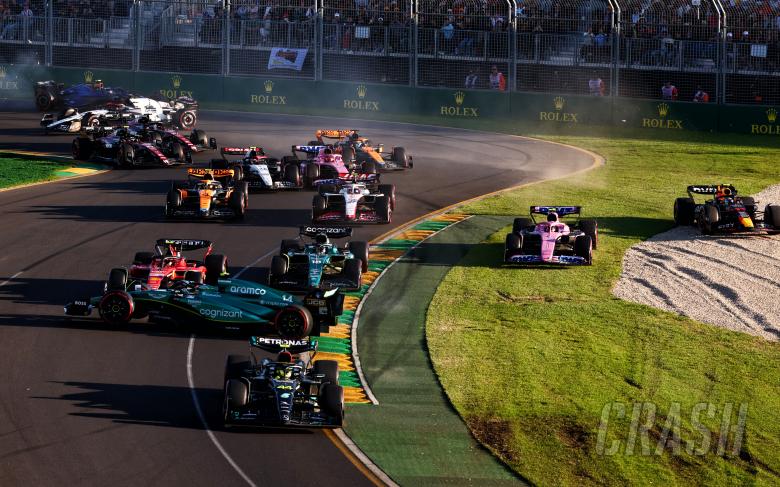Does F1 need restart rethink after Melbourne mayhem at Australian GP?


The 2023 Australian Grand Prix will be remembered as one of the most dramatic, chaotic and downright craziest races in recent F1 history.
Chaos and confusion reigned supreme at an incident-packed Australian Grand Prix with no fewer than two Safety Cars and three red flags amid the mayhem in Melbourne.
The first red flag - for gravel and debris thrown onto the track by Alex Albon’s shunt - raised question marks and arguably ruined the race. The second, which followed an initial Safety Car period just like the one that preceded it, was again for significant debris that littered the track after Kevin Magnussen hit the wall on Lap 54.
This set up a second standing restart and teased the prospect of a thrilling two-lap dash to determine the winner. But chaos ensued when Fernando Alonso was pitched into a spin at Turn 1 and several others crashed, resulting in a third and final red flag.
The FIA applied a similar principle to last year’s British Grand Prix and considered the start void, prompting confusion and controversy over the order and how the race would conclude. After some delay, it finished with the order reset and a single tour behind the Safety Car.
A final classification was not published until late in the evening when a subsequent protest of the result by the Haas team was dismissed.
Many observed how the decisions made in Australia reflected F1’s desire to ensure races finish under green flag conditions, and some argued it highlighted a push towards increased entertainment.
Max Verstappen blamed race control for the “mess”, George Russell felt the first red flag was “totally unnecessary”, and even Alonso, who gained more than most from the final stoppage, admitted he was “surprised” by the calls.
So is a rethink, or some procedural clarity, needed?
"The whole point of red flagging - it feels like it was just to put on a show,” said McLaren’s Lando Norris.
“I’m the one driving the car, so I feel like I could have been so unlucky for no reason. I easily could have crashed with [Nico] Hulkenberg at the end, because you've got people going off and you're suddenly swerving and things like that.
"So, we've come all the way to Australia but it's so much hard work driving 55/56 laps perfectly and, because they try and put on a show, you just get unlucky and everything can get taken away from you all of a sudden.
“I just think it needs a small re-think. I don't think it needs a change, it just needs a small re-think in my opinion."
The dissatisfaction will increase the pressure already facing the FIA. F1’s governing body has regularly been criticised over its decision-making in recent seasons, which peaked at the controversial 2021 Abu Dhabi Grand Prix.
In the now notorious title-deciding showdown, Michael Masi’s incorrect handling of a late Safety Car directly influenced the championship outcome, denying Lewis Hamilton a record eighth title and allowing Verstappen to snatch his first.
And the man at the heart of one of F1’s biggest controversies was there to witness what appeared to be a shambolic race ending in his first appearance back in the paddock since that fateful night in Abu Dhabi.
A defence for the FIA
Not everyone disagreed with the way the race was handled.
Despite the confusion, the rules were ultimately followed by race director Niels Wittich and the FIA, as Mercedes boss Toto Wolff pointed out.
“We looked it up - it was the rulebook,” Wolff said. “It was a bit confusing but it was like it’s written down.
“Obviously, results like this are good for some teams and bad for others but, if you throw a red flag and you have a crash with a lap to go…
“I just got a call from Susie [Wolff, Toto’s wife]. She said that it was great entertainment in the early morning on a Sunday.
“I don’t know whether it was. We’re so in our little bubble here looking at laptimes!”
Although there was a risk Verstappen could have missed out on victory, Red Bull team principal Christian Horner said the final red flag was “the right thing to do”.
"When you're the leader, you can only lose from that point,” he explained. “You can understand the rationale between wanting to finish under racing conditions rather than cruising behind the safety car for three laps.
"They might have been able to clear the circuit and get it going, I don't know. Like all these things, there's always something to learn.”
Sky Sports F1’s Martin Brundle also defended the FIA.
"I don't think there was any instruction to whizz this show up when required," Brundle said. "You have to walk a mile in the shoes of the people who are responsible.
"It is easy for us to sit on the sidelines going 'should have done this, should have done that’.
"Back in 2009, Felipe Massa nearly died with a piece of someone else's car coming through his cockpit.
"It is also a street circuit there with a lot of fans either side of the track and also marshals and medics that are down there. So, if there are pieces of debris on the track, you can't have them flying through the air at a couple hundred miles per hour.
"I thought when Alex Albon went off they could perhaps have just used a Safety Car and swept the gravel up and cleared the car away.
"A red flag perhaps seemed slightly unnecessary but towards the end of the race, we had a tyre and wheel on the track and lots of debris.
"I am absolutely confident no one is in there going 'hey, let's make this a little bit more fun’.
"Whether we are making crystal-clear decisions in the pressure of the moment, obviously we lost Charlie Whiting in Melbourne where he died sadly, then we went through the Michael Masi phase which everybody knows about, especially Abu Dhabi 2021.
"Then they shared the role, now we have a guy called Niels Wittich.
"Is he making the right decisions? But at the end of the day, we are sitting here and we are not one percent responsible if somebody was killed or injured."
What played out in Melbourne will no doubt continue to be a point of discussion that rumbles on into the next race.



